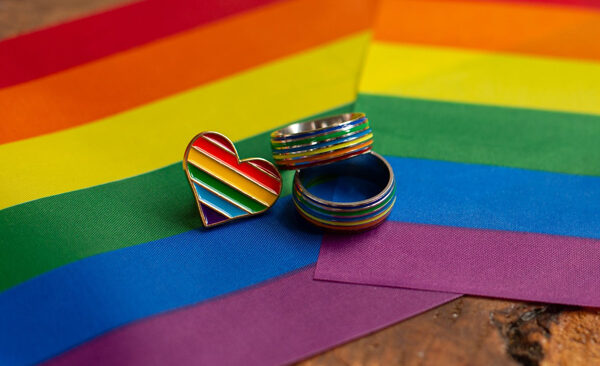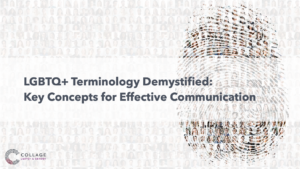Understanding and Embracing LGBTQ+ Terminology

The LGBTQ+ segment is large and growing. An important part of connecting with the segment is understanding and embracing LGBTQ+ terminology. Read on for more information on what terms the community prefers for group and individual identifiers, as well as how and when they prefer to use pronouns.
When talking about the LGBTQ+ community, there are seemingly endless acronyms, terms, and flags to choose from, and it can be difficult to know which ones to use. Getting terminology right is about more than saying the right word to refer to the right person, it’s about dignity and empathy. Terminology is really a matter of respect: saying I see you, and I affirm your identity. In our recent study, we focused on how the LGBTQ+ community uses community and individual identifiers, as well as pronouns. Continue reading for key insights on each.
Fill out the form to download slides from our research report.

Community Identifiers
At Collage Group, we use “LGBTQ+” to refer to any and all people who are anything except straight and cisgender – that is, people who are attracted to their same gender, multiple genders, people who don’t experience sexual attraction, transgender and non-binary people, and a whole host of others that fall under the “plus”.
To lay it out more specifically:
- L and G: Lesbian and gay, those who are attracted to people of the same gender.
- B: Bisexual, those attracted to multiple genders.
- T: Transgender, a term different in kind than the previous three and referring to those who identify with a gender other than the one they were assigned at birth.
- And finally Q+: Queer and questioning. And the plus refers to all the other labels out there – pansexual, asexual, non-binary, and beyond.
Collage Group uses this term because it allows us to be specific and inclusive, referring to the whole community and the subgroups. There’s a lot of ambiguity in acronyms like these, it’s hard to place firm definitions on people – Everyone is complicated, likely to change and famously resistant to being put in boxes!
When we asked the segment to choose their preferred terms, LGBTQ+ came out on top, followed by LGBTQ. Within subgroups, we see that younger and gender non-conforming people (those identifying as transgender and/or non-binary) were more likely to pick expansive options like LGBTQ+ and LGBTQIA+, and less likely to pick narrower terms like “gay community.” This data shows that young and gender non-conforming people – who are mostly, themselves, young – are more understanding of the diversity of the community and want to recognize it and call it out.
This focus on diversity also shows up in the evolution of the Pride Flag in recent years. While LGBTQ+ people are still most likely to use the traditional rainbow flag to represent the community, younger and gender non-conforming people are gravitating more towards the newer Progress and Intersex Progress Pride flags, which include colors to represent the transgender and intersex communities as well as people of color.
Young and Gender Non-conforming LGBTQ+ People Are Especially Likely to Use “LGBTQ+” as a Community Term
Which of the following terms do you most often use to describe the community of people who do not identify as straight/heterosexual and/or with the gender assigned to them at birth? (LGBTQ+ Respondents)
Individual Identifiers
When it comes to the terms people use to describe themselves, we see an incredible variety and some terms we might expect to be less common are actually resonating with a lot of people. The terms pansexual and queer were very popular (pansexual referring to being attracted to all genders). This reflects the growing idea that sexuality is fluid and people prefer not to put themselves boxes.
We also see 4% and 3% of LGBTQ+ people identifying as asexual and demisexual, respectively. These are terms for people who either do not experience sexual attraction (asexual), and people who only experience sexual attraction to people they feel an emotional connection to (demisexual). We also asked about aromantic and demiromantic. These terms refer to people who never or only sometimes experience romantic attraction.
The separation of romantic and sexual attractions opens a whole other world of terminology, and we could only fit in some of it in the survey. For example, someone might identify as asexual and panromantic, meaning they do not experience sexual attraction but can experience romantic attraction to people of all genders. That’s why we allowed people to choose more than one term here. The ways that people refer to themselves are infinite.
This blog includes a small sample of the deep cultural intelligence available to our members. Contact us to learn how you can unlock full access to our Cultural Intelligence Engine.